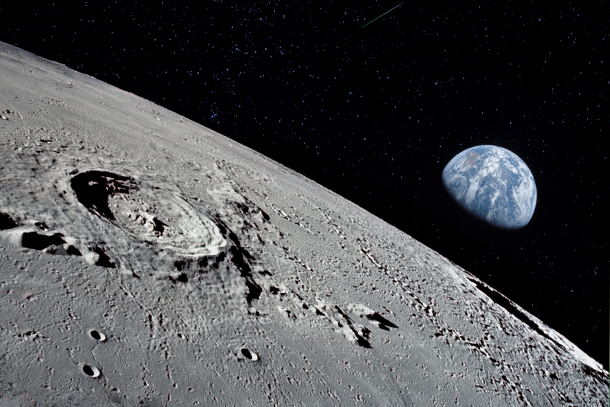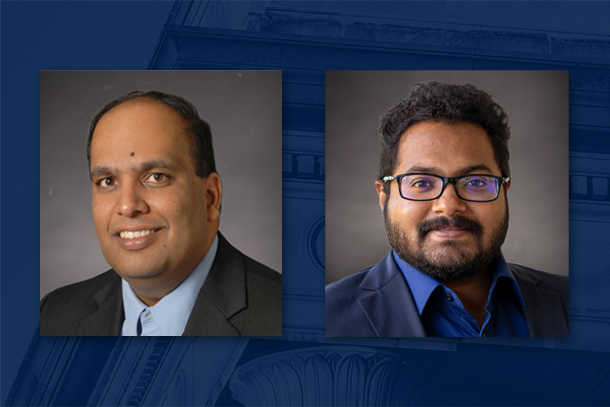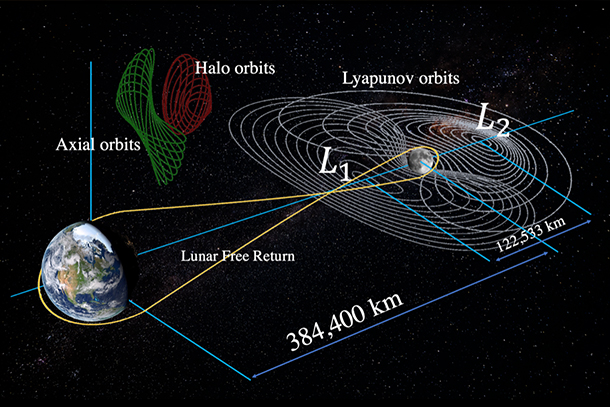
Penn State aerospace engineering faculty members Puneet Singla and Roshan Eapen are part of a $4.5 million project studying cislunar space, the region between the moon and Earth's geosynchronous orbit that is critical for enabling future space exploration. Credit: Ellen11/iStock
Q&A: What is the space between Earth and the moon and why does it matter?
Penn State aerospace engineering researchers to aid understanding of the cislunar region, a zone critical to future space exploration, as part of a multi-institutional project
November 7, 2023
By Andrew Krebs
UNIVERSITY PARK, PA. – Two faculty members in the Penn State Department of Aerospace Engineering, Professor Puneet Singla and Assistant Professor Roshan Eapen, are part of a team of researchers from four universities collaborating on a $4.5 million project to better understand cislunar space — the area between Earth and the moon — critical for future space exploration.

Professor of Aerospace Engineering Puneet Singla (left) and Assistant Professor of Aerospace Engineering Roshan Eapen. Credit: Penn State College of Engineering
The Characterizing Highways and Automated Navigation in Cislunar Environment (CHANCE) project, funded by the Air Force Office of Scientific Research and led by Purdue’s Kathleen Howell, also includes co-principal investigators from Georgia Tech and the University of Texas at Austin.
Singla discussed the three-year CHANCE project in a Q&A.
Q: What should readers know about the cislunar environment?
Singla: Cislunar space is the term used for the region beyond Earth’s geosynchronous orbit (GEO) that is primarily governed by the gravitational influence of both the Earth and the moon. GEO is around 36,000 kilometers from the surface of the Earth and the moon is approximately 384,400 kilometers away from the Earth, so cislunar space is vast!
Q: What role will cislunar space play in future exploration, such as crewed missions to Mars and beyond?
Singla: The ARTEMIS program is planning to send humans back to cislunar space for the first time since the Apollo era and NASA estimates that traffic in cislunar space over the next 10 years will exceed all that occurred in this region since the beginning of space age in 1950s. This huge interest stems from humanity’s desire to explore our solar system for in-situ resource utilization, radio astronomy, lunar mapping and mining, among many other exploration activities.
With the moon’s gravity being one-sixth of Earth’s gravity, significantly less propulsion is required to navigate within cislunar space and the costs to explore the solar system using the moon as a launching platform are much cheaper. Additionally, special regions in cislunar space near the moon, often referred to as Lagrange points, offer many options for both the storage of propellant and supplies for lunar missions, as well as potential locations for a space-based facility to support future crewed and robotic missions for solar system exploration.
Q: Why is currently available information about near-Earth orbits insufficient for longer-range space travel?
Singla: The motion of a spacecraft in orbits around Earth is mainly governed by the gravitational force of the Earth and by Kepler’s three laws of planetary motion. This two-body problem — spacecraft and the Earth being the two bodies — has been studied very well. We have extensive modeling, analysis and near-exact solutions to study spacecraft motion.
However, beyond Earth’s geosynchronous orbit, (XGEO), the dynamical environment shifts, and the structure of fundamental behaviors are radically different. Kepler’s laws don’t apply in the same ways, chaotic motions, data sparsity from limited coverage and availability of sensors all limit the transferability of tools and techniques.

A not-to-scale illustration showing various orbit patterns, representing the extreme variability in the cislunar region. Credit: Provided by Roshan Eapen
Traditional data structures such as orbital elements in XGEO are not sufficient. In the absence of a global positioning system, accurate guidance and navigation capabilities are challenging. The effective gravitational acceleration is typically an order of magnitude smaller than for spacecraft in a low-Earth orbit. Hence, less propulsion is required to make large changes in position and velocity. Of course, the associated bad news is that the nominal trajectories are more easily disturbed in the presence of model, navigation and control errors.
Q: What expertise and capabilities do you bring to CHANCE and on what specific challenges will you focus as part of Penn State’s contributions to the project?
Singla: In close collaboration with my colleague, Dr. Eapen, we are going to develop analytical approaches and computationally efficient algorithms for improved understanding of spacecraft motion in the XGEO environment and leverage these insights for accurate navigation, trajectory planning and control under uncertainty for an extended period of time.
Dr. Eapen is an expert in dynamical system theory while my research work is concentrated on development of uncertainty quantification and guidance algorithms for aerospace vehicles. We are going to leverage linkages between dynamical systems theory and uncertainty quantification to develop new tools for rapid generation of roadmaps in cislunar space.
The CHANCE primary investigator, Dr. Howell, is the expert in multi-body dynamics and has contributed to multiple space missions. In close collaboration with her, we are also going to study the effect of non-conservative forces — solar radiation pressure and external thrust — as well as conservative forces due to other planets and bodies in the solar system. These studies will provide new data structures to classify different trajectories in cislunar space.
Q: What are the anticipated benefits of CHANCE?
Singla: The successful completion of the CHANCE project will provide us a better understanding of transfers across different regions in cislunar space, especially considering thrust and fuel limitations, navigation uncertainty and computational bottlenecks. It will provide new control and navigation tools for improved monitoring methods in cislunar space. All of this together will provide us with tools for rapid situational awareness to aid in sustaining safe operations without persistent ground support.
Just as importantly, the CHANCE project will support 14 students from four different institutions, which will help in training next-generation workforce in this critical area of national need. Our collaboration with government and industry partners will help us build an enduring research community dedicated to supporting national interests in the cislunar region.
Q: What are some of the ways that Penn State’s space systems research evolved in recent years?
Singla: The Astrodynamics Research Group of Penn State – a lab in the Department of Aerospace Engineering that brings together efforts across the University in areas such as motion of Earth satellites, interplanetary mission design and spacecraft situational awareness – has more than tripled in last three years among its student population.
The faculty is involved in multiple projects related to tracking space objects in different orbits around the Earth as well as in the XGEO environment, deployable space structures, rendezvous and proximity operations, etc. We are working closely with U.S. Space Force researchers to protect national assets in space.
Dr. Eapen is currently in process of setting up a telescope observatory in New Mexico to collect data for different space objects, and researchers from Penn State’s Applied Research Lab are also supporting our work in tracking and characterizing space objects from ground observations.
Astrodynamics and space operations is a growing area at Penn State.



